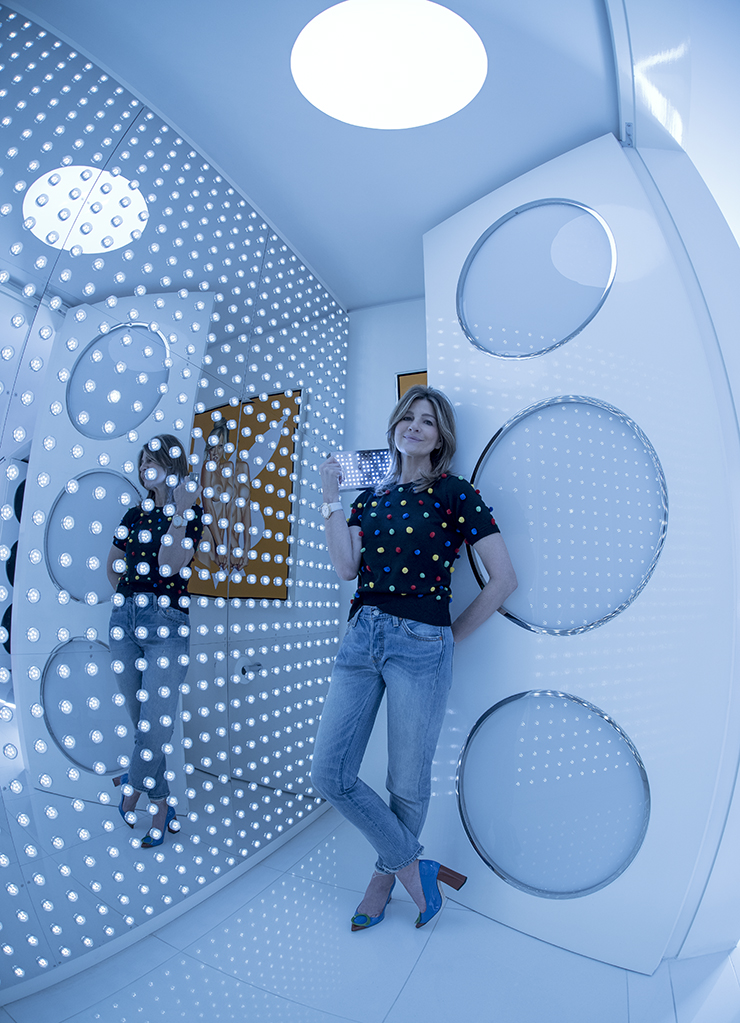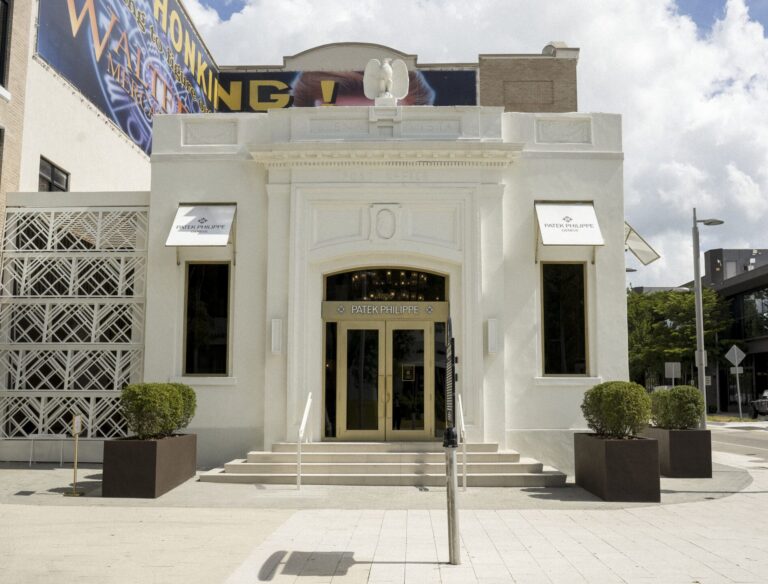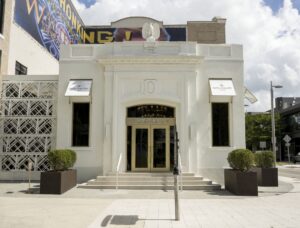
Designer Lisa Perry’s creations always turn heads. From her vividly hued, vintage-inspired fashions to her renowned artist collaborations, she has generated a signature style all her own. This spring, after working with imagery from such artists as Andy Warhol, Jeff Koons and Robert Indiana, she lit up the fashion world with an LED-powered clutch dubbed the Scintillator, whose illuminated light display was engineered by artist Leo Villareal. But the spotlight is also shining on her clothing worn on the campaign trail by Hillary Clinton, whom Perry has supported since her 2000 Senate campaign. Here, she discusses her design inspirations, her sparkling work with Villareal and why this is the Year of Women.
What instigated your collaboration with Leo Villareal? I am a collector and love his work. We first bought a sculpture for my husband’s office a long time ago. More recently we decided to replace a sculpture installed in a small powder room in our home and I thought that given the space’s intimacy it would be a good place for his work. Leo is so talented and really a visionary, combining his artistic skills with technological innovation. I looked at the sculpture he created and thought about how I could translate it into fashion, which is how my eye sees things. I realized the sculpture could become a great evening bag—those lights in those low-lit rooms and spaces.
There is a performative subtext to this work, which I suspect relates to the sculpture that inspired it. Can you speak to that? The Scintillator functions as a living piece of art, and it creates a conversation about the artist. We were also able to link it to a monumental event from last winter, Leo lighting the Bay Bridge in San Francisco, The Bay Lights permanent installation.
Do you find it is a different buyer for your artist collections than your other work? Yes, but there is some crossover. The artist collections are often bought by collectors. Leo’s Scintillator bag, was even purchased by one man who saw it as a sculpture. But yes, the artist collections extend beyond the people who usually buy my clothing. A woman came in and bought the entire Jeff Koons collection because she is a major collector of his work.

Previous artist collections you presented seem to be more about using art as a visual layer on your designs rather than the outright creation of new ideas, as you have done here with Leo Villareal. Does this change the way you want to approach future artist collections? Yes! I love this process of creating something from scratch. It is extremely gratifying. We made a new piece of art. Hillary Clinton is a big fan of your clothing. How did your involvement with her begin? I first met Hillary at an event supporting Chuck Schumer’s Senate campaign. We sat at a table together with a group of women, and I saw how much work there was to be done. At the time there were 91 male Senators to nine female, and I was working to get more women elected. Hillary was warm and welcoming and I began to support her Senate campaign. In 2000 I helped organize a fundraising event, really the first of its kind, at Gagosian Gallery. I have remained involved throughout her political career.
What kind of response have you had now that she has been wearing Lisa Perry on the campaign? Very positive. People call me when they recognize the clothes, saying, ‘Hillary’s wearing LP.’ Given that her wardrobe has been subject to public debate, what significance do you think it carries that she wears your designs? Well, it shows she is willing to think out of the box with a designer she feels comfortable in.
You merge art, design and fashion in your work. Has seeing your clothing in the political arena affected your views on fashion? It reaffirms my feeling that we are doing something very special, something with a strong DNA. It’s recognizable: On the street you identify the circle pocket, or the tunic with a square pocket. The geometric shapes and colors make a statement that’s important today. When I’m asked to give advice about getting into fashion, my answer is to have a point of view. It helps the process and the collections and can be immediately translated to other areas of design, such as home.
Does vintage fashion continue to inspire your work? What about art, architecture and design? I always lean towards vintage fashion and other great design of the ’60s, but past collections have also been inspired by architecture, art and furniture. Gio Ponti, for instance, crossed over into so many areas. My business is fashion but I could easily go into home design and accessories. I recently went to Palm Springs to give a talk at Modernism Week and had the opportunity to tour the John Lautner Elrod House and the Bob Hope home. I had such a visceral reaction there—it’s an incredible world focused on design.
How does that translate to fashion? My dresses are statements to architecture. I’m a minimalist at heart. It’s a minimalist approach to fashion—solid dresses without embellishments—and you don’t see that a lot.
I always drew a connection from your fashion work to your Pop Art collection. Do you also collect minimalism? I do. My home on Long Island is filled with minimalism and the California Cool School: works by artists like John McCracken and Larry Bell. My true love is minimalism.
I’m intrigued by your latest lookbook, which is a group of Polaroid photographs you took yourself. Can you talk about the women you featured? I look at 2016 as the Year of Women. I’ve been supporting women for years but we have more work to do. For our FW16 collection I was inspired by Sonia Delaunay, a Ukrainian-born French abstract artist and feminist who specialized in strong color and geometric shapes. For the first time I got behind the lens to shoot women of influence from a variety of fields.
Can you tell us about some of the women you featured? I wanted to celebrate the women I support and admire, like Cecile Richards, the president of Planned Parenthood. Considering everything she’s gone through and these daily attacks, even the basis of her federal funding, it’s unbelievable. She is on the road constantly and for her to take the time to do this was incredible. We also had Dr. Orli Etingin, head of the Women’s Health Center at New York-Presbyterian hospital. She is an incomparable pioneer in the field of women’s health. We had established women and young women, like the Met’s Kimberly Drew, aka @museummammy. It was a great group. And for me to get behind the lens was an added bonus.











 in your life?
in your life?

